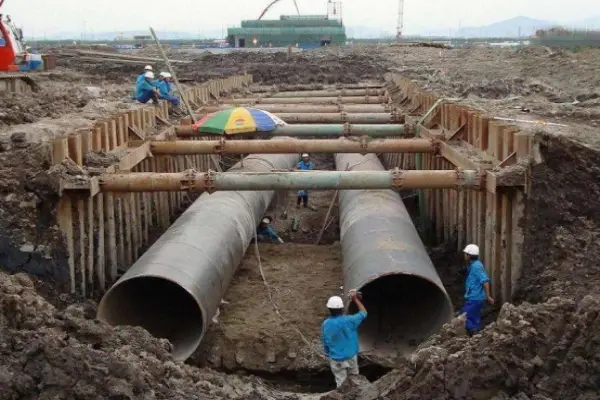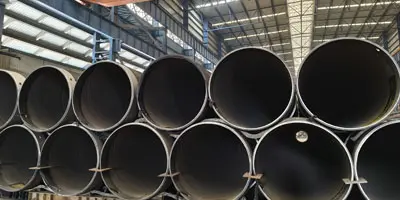Steel Pipe Pile vs Concrete Pile: Which Is Better?
Choosing between steel pipe piles and concrete piles is crucial in the construction of infrastructures such as bridges, buildings, and piers. Both types of piles offer advantages and disadvantages depending on soil conditions, project type, and budget. In this article, we will explore the differences between steel pipe piles and concrete piles, highlighting their features, applications, and which might be the best option under various circumstances.
What Are Steel Pipe Piles?
Steel pipe piles are long steel tubes that are driven or inserted into the ground to provide support for a structure. They are known for their high load-bearing capacity and durability, making them suitable for projects in challenging terrains. These piles can be made from various types of steel, such as galvanized steel, or steel with special coatings to enhance their corrosion resistance.
Steel Pipe Piles is a type of Piling Pipe, specifically referring to pile pipes made of steel pipes, which are usually used in projects with high bearing capacity requirements and harsh environmental conditions. Piling Pipe is a broader term that covers all pipes used for pile foundations, including steel pipes, concrete pipes, etc.
What Are Concrete Piles?
Concrete piles, also known as reinforced concrete piles, are made from concrete reinforced with steel bars. They are widely used due to their cost-effectiveness and ease of installation. Concrete piles are suitable for stable ground and are highly effective in bearing heavy loads, though their load-bearing capacity may be lower compared to steel pipe piles in more challenging terrains.
Advantages of Steel Pipe Piles
1.High Load-Bearing Capacity
Steel pipe piles are known for their ability to support significant loads. Due to their structural strength, they can handle much higher loads than concrete piles. This makes them ideal for projects that require high strength, such as bridges, skyscrapers, and industrial structures.
2.Corrosion Resistance
Steel pipe piles, especially those that are galvanized or coated, offer excellent resistance to corrosion. This is crucial in marine or damp environments, where unprotected steel can deteriorate quickly. For example, in offshore projects or coastal areas, steel pipe piles provide a durable and reliable solution.
3.Flexibility in Challenging Terrains
Steel pipe piles are more flexible than concrete piles, which allows them to adapt better to unstable soils. They can be more effective in soft soils, such as clays or saturated soils, where concrete piles might fail or not be as efficient.
4.Quick Installation
Steel pipe piles are installed more quickly than concrete piles. This can be a deciding factor in projects that require fast and efficient construction.
Advantages of Concrete Piles
1.Lower Initial Cost
In terms of initial costs, concrete piles are usually more economical. Concrete is an abundant and low-cost material, which reduces expenses compared to steel materials. This advantage makes concrete piles preferred for projects with limited budgets or when building on stable ground.
2.Easy Installation in Stable Soils
In stable soils, concrete piles are installed quickly and without complications. They do not require specialized equipment for installation, which reduces labor costs and construction time.
3.Natural Corrosion Resistance
Concrete piles are naturally resistant to corrosion. This makes them an ideal choice for projects in areas where there is no exposure to extreme conditions, such as desert regions or inland areas where moisture is not a significant factor.
4.Less Maintenance
Compared to steel pipe piles, concrete piles require less maintenance over time. Although the steel reinforcement inside the concrete may corrode, the exterior concrete provides a protective barrier, making it ideal for projects with a long lifespan.
Key Differences: Steel Pipe Pile vs. Concrete Pile
|
Characteristic
|
Steel Pipe Pile
|
Concrete Pile
|
|
Initial Cost
|
Higher due to material and manufacturing process
|
Lower, suitable for budget-constrained projects
|
|
Installation
|
Quick, especially in difficult terrains
|
Easy and quick in stable soils
|
|
Load-Bearing Capacity
|
Very high, suitable for heavy loads
|
Suitable for medium-load projects
|
|
Durability
|
High, especially in damp and marine environments
|
Good in normal conditions, less effective in corrosive environments
|
|
Flexibility
|
High, adapts well to soft and difficult soils
|
Less flexible, ideal for stable soils
|
What types of steel pipes can be used as steel pipe piles?
Steel pipe piles are essential for constructing heavy-duty infrastructure like bridges, ports, and buildings. There are several types, each suited for specific project needs:
LSAW (Longitudinal Submerged Arc-Welded Pipe): Ideal for large-diameter, thick-wall piles used in heavy-load structures.
SSAW (Spiral Submerged Arc-Welded Pipe): Flexible in production, suitable for long-distance or flexible pile systems.
Heat-Expanded Pipe: Cost-effective for large diameters, used in large building foundations and deepwater constructions.
Galvanized Pipe: Zinc-coated for high corrosion resistance, used in marine and coastal projects.
Alloy Steel Pipe: Enhanced for high-temperature and corrosion resistance, ideal for extreme conditions.
Choosing the right type ensures the foundation's strength, durability, and reliability for the project.

Steel Pipe Piles vs Concrete Piles: Which One is the Best Choice for Your Project?
The choice between
steel pipe piles and concrete piles depends on several factors. If the project is located on stable ground and the budget is limited, concrete piles might be the most suitable option. They are more affordable and install quickly in normal conditions.
However, if the terrain is challenging, such as in marine areas or with soft soils, steel pipe piles offer higher load-bearing capacity and flexibility. Moreover, their corrosion resistance and durability make them more suitable for projects in extreme conditions.
In summary, both types of piles have their advantages and are suitable for different types of projects. The key is to carefully assess the site conditions, project type, and budget before making a decision. By doing so, the most suitable type of pile can be selected, ensuring a solid and durable foundation for the structure.






 English
English Español
Español بالعربية
بالعربية











 Phone :
Phone :  Whatsapp :
Whatsapp :  Email :
Email : 


